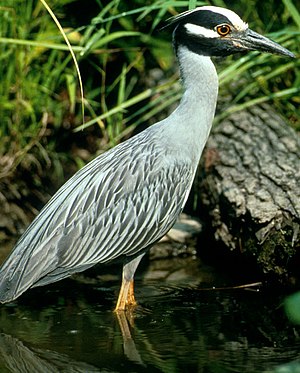Crab heron
| Crab heron | ||||||||||||
|---|---|---|---|---|---|---|---|---|---|---|---|---|

Crab Heron ( Nyctanassa violacea ) |
||||||||||||
| Systematics | ||||||||||||
|
||||||||||||
| Scientific name | ||||||||||||
| Nyctanassa violacea | ||||||||||||
| ( Linnaeus , 1758) |
The crab heron ( Nyctanassa violacea , Syn. : Nycticorax violaceus ) is a bird art from the family of herons .
features
This graceful heron reaches a length of 61 cm and a weight of 625 g. It resembles the night heron ( Nycticorax nycticorax ) in its appearance , but is significantly slimmer than this. Its head is relatively large and its beak is noticeably thick. Its body plumage is predominantly dark gray on the upper side with silvery edges and white gray on the belly. His head, on the other hand, is black with a white to yellowish forehead, an equally colored head of feathers and white stripes under the eyes. During the mating season, the forehead and cheeks turn yellow and long, white decorative feathers grow on the back of the head. He has red eyes and short, yellow legs. The sexes are similar, the plumage of the young birds is brown with white or gray spots.
Occurrence
It breeds in the coastal area of the southern USA , in the Caribbean , almost all of Central America and in northern South America . The northern populations are considered to be migratory birds . Its preferred habitat are coasts , mangroves and coastal wetlands .
behavior
In the warmer parts of its range, the crab heron is a resident bird , but the birds from the northern parts migrate to Central America and the Caribbean in winter. Crab herons hunt individually and lie in wait for prey at the water's edge. Their preferred food is crustaceans , but amphibians , insects and molluscs are also preyed on. Fish , on the other hand, only makes up a very small part of his diet. Like the night heron, the crab heron mostly searches for food in the dark, even if it is more diurnal than the night heron. The herons build their nests of twigs and reeds in pairs or in loose colonies. They usually nest in trees or bushes near the water. There the female lays two to five blue-green eggs . The rearing of the young is carried out jointly by both parents.
literature
- National Geographic Society: Field Guide to Birds of North America. Washington DC 1999.
- David Sibley: The North American Bird Guide. London 2000.
Web links
- Nyctanassa violacea in the endangered Red List species the IUCN 2011. Posted by: BirdLife International, 2009. Accessed November 13, 2011th
- Nycticorax violaceus in the Internet Bird Collection